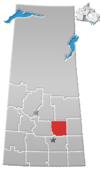Punnichy
Punnichy | |
|---|---|
Village | |
Location of Punnichy in Saskatchewan | |
| Coordinates: 51°22′19″N 104°17′35″W / 51.372°N 104.293°W | |
| Country | Canada |
| Province | Saskatchewan |
| Region | Saskatchewan |
| Census division | 6 |
| Rural Municipality | Mount Hope |
| Post office | 1909-04-01 |
| Incorporated (Village) | 1909 |
| Government | |
| • Mayor | Victor Senft |
| • Administrator | Dixie-Lee Cowan |
| • Governing body | Punnichy Village Council |
| Area | |
| • Total | 0.68 km2 (0.26 sq mi) |
| Elevation | 610 m (2,000 ft) |
| Population (2011)[1] | |
| • Total | 245 |
| • Density | 363.3/km2 (941/sq mi) |
| Time zone | UTC−6 (CST) |
| Postal code | S0A 3C0 |
| Area code | 306 |
| Highways | Highway 15 |
| Railways | Canadian National Railway |
| [2][3] | |
Punnichy /ˈpʌnɪtʃaɪ/ (2016 population: 213) is a village in the Canadian province of Saskatchewan within the Rural Municipality of Mount Hope No. 279 and Census Division No. 10. It is 126 km (78 mi) northeast of the City of Regina. This village is part of the original "Alphabet Line" of the main Canadian National Railway line with Lestock to the east and Quinton to the west (the M, N, O towns have long since been deserted). Punnichy derived its name from panacay, "fledgling bird with few feathers", a Saulteaux joke referring to the appearance of a pioneer merchant.
Punnichy is along Highway 15 in the heart of the Touchwood Hills between Quinton and Lestock. It is surrounded by four First Nation reserves: Muskowekwan, Kawacatoose, Daystar and Gordon. Punnichy was the location of one of the last operating residential schools in Canada, Gordon Indian Residential School, which closed in 1996.
Punnichy is part of the provincial constituency Last Mountain-Touchwood and federal constituency Regina—Qu'Appelle.
In 2009, Punnichy celebrated its centennial.
History[edit]
Punnichy incorporated as a village on October 22, 1909.[4]
Demographics[edit]
In the 2021 Census of Population conducted by Statistics Canada, Punnichy had a population of 212 living in 79 of its 87 total private dwellings, a change of -0.5% from its 2016 population of 213. With a land area of 0.68 km2 (0.26 sq mi), it had a population density of 311.8/km2 (807.5/sq mi) in 2021.[7]
In the 2016 Census of Population, the Village of Punnichy recorded a population of 213 living in 83 of its 117 total private dwellings, a -15.5% change from its 2011 population of 246. With a land area of 0.68 km2 (0.26 sq mi), it had a population density of 313.2/km2 (811.3/sq mi) in 2016.[8]
Education[edit]
Punnichy has an elementary school, high school and a Carlton Trail Regional College centre.
Punnichy Community High School is unique within the Horizon School Division, in that it is run on the quadmester system, with 4 terms in a school year. The students take four classes in the first quadamester, two each morning and another two each afternoon. The first quadmester lasts 90 school days and the remaining 3 each last about 35 days. In the last 3 quadmesters, students take one class all morning and another all afternoon.[9]
A satellite facility of Punnichy high school is the George Gordon Computer Education Centre in the community centre on Gordon First Nation. The facility assists First Nations students to return to school or pick up extra classes to move into post-secondary or job training. The program is "at your own pace" and is similar to "store front" programs in urban centres.
Gordon's Indian Residential School, located in Punnichy and which closed its doors in 1996, was one of the last federally-funded residential school in Canada.[10][11][12]
Notable people[edit]
- Nolan Yonkman, a defenceman for the Florida Panthers, was born in Punnichy.
- Ernest Luthi, noted Saskatchewan artist
- Jim Sinclair, Indigenous political leader
- Dr. Raymond Sentes- Professor of Political Science, Anti-Asbestos Activist[13]
- Jeffery Straker, singer
See also[edit]
References[edit]
- ^ "2011 Community Profiles". Statistics Canada. Government of Canada. Retrieved 2014-08-21.
- ^ National Archives, Archivia Net. "Post Offices and Postmasters". Retrieved 2014-08-21.
- ^ Government of Saskatchewan, MRD Home. "Municipal Directory System". Retrieved 2014-08-21.
- ^ "Urban Municipality Incorporations". Saskatchewan Ministry of Government Relations. Archived from the original on October 15, 2014. Retrieved June 1, 2020.
- ^ "Saskatchewan Census Population" (PDF). Saskatchewan Bureau of Statistics. Archived from the original (PDF) on September 24, 2015. Retrieved May 31, 2020.
- ^ "Saskatchewan Census Population". Saskatchewan Bureau of Statistics. Retrieved May 31, 2020.
- ^ "Population and dwelling counts: Canada, provinces and territories, census divisions and census subdivisions (municipalities), Saskatchewan". Statistics Canada. February 9, 2022. Retrieved April 1, 2022.
- ^ "Population and dwelling counts, for Canada, provinces and territories, and census subdivisions (municipalities), 2016 and 2011 censuses – 100% data (Saskatchewan)". Statistics Canada. February 8, 2017. Retrieved May 30, 2020.
- ^ Horizon School Division # 205. "Punnichy Community High School". Retrieved 2014-08-21.
{{cite web}}: CS1 maint: numeric names: authors list (link) - ^ Miller, J.R. 2012 October 10. "Residential Schools in Canada." The Canadian Encyclopedia (last edited 2020 September 2).
- ^ "Gordon’s." National Centre for Truth and Reconciliation.
- ^ "Shattering The Silence The Hidden History of Indian Residential Schools in Saskatchewan eBook". University of Regina. Retrieved May 29, 2021.
- ^ "Ray Sentes Brave Fighter for Asbestos Victims".



